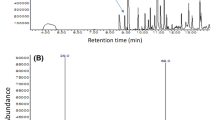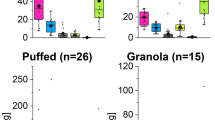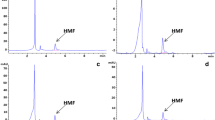Abstract
Furan, which has been identified as possibly carcinogenic for humans, can be induced to different food items by thermal treatment. In accordance with the previous studies and risks associated with prevalence of furan in food, it is necessary to be acknowledged of amounts of furan formed in different thermally processed foods for human awareness. In this study, Headspace Solid-Phase Microextraction Gas Chromatography–Mass Spectrometry (HS-SPME-GC/MS) was optimized for simultaneous determination of furan, furfural, 2-methylfuran and 2-pentylfuran for the first time from different dried fruits and roasted nuts. The method was proved to be valid for determination of all analytes at 50 °C for 25 min, stirring at 700 rpm and 20% NaCl (W/V) using 50/30 μm divinlybenzene/carboxen/polysimethylsiloxane (DVB/CAR/PDMS) fibre. All analytes were baseline-separated at HP 5-MS column in less than 13 min and obtained results have shown prevalence of furan, furfural and 2-pentylfuran in the studied matrices; however, 2-pentylfuran was more prevalent in the roasted nuts than dried fruits and 2-methylfuran has not shown considerable prevalence in both matrices. Moreover, this method was validated in terms of linearity, precision, recovery, specificity, limit of detection and limit of quantification depending on analytes and sample matrices. Hence, the present method was proved to be highly sensitive, specific and robust with good precision and accuracy and suitable for monitoring these furan derivatives in the studied matrices.



Similar content being viewed by others
References
Locas CP, Yaylayan VA (2004) Origin and mechanistic pathways of formation of the parent furan A food toxicant. J Agric Food Chem 52:6830–7683. https://doi.org/10.1021/jf0490403
Owczarek FA, Meulenaer BD, Scholl G, Adams A, Lancker FV, Yogendrarajah G, Eppe ED, Pauw ML, Kimpe MD (2012) Furan formation in starch-based model systems containing carbohydrates in combination with proteins, ascorbic acid and lipids. Food Chem 133:816–821. https://doi.org/10.1016/j.foodchem.2012.01.098
Shen M, Liu Q, Jiang Y, Nie S, Zhang Y, Xie J (2015) Influences of operating parameters on the formation of furan during heating based on models of polyunsaturated fatty acids. J Food Sci 80(6):T1432–T1437. https://doi.org/10.1111/1750-3841.12864
Fromberg A, Mariotti MS, Pedreschi F, Fagt S, Granby K (2014) Furan and alkylated furans in heat processed food, including home cooked products. Czech J Food Sci 32:443–448. https://doi.org/10.17221/341/2013-cjfs
Limacher A, Kerler J, Davidek T, Schmalzried F, Blank I (2008) Formation of furan and methylfuran by Maillard-type reactions in model systems and food. J Agric Food Chem 56:3639–3647. https://doi.org/10.1021/jf800268t
Fan X (2015) Furan formation from fatty acids as a result of storage, gamma irradiation UV-C and heat treatments. Food Chem 175:439–444. https://doi.org/10.1016/j.foodchem.2014.12.002
Fan X, Geveke DJ (2007) Furan formation in sugar solution and apple cider upon ultraviolet treatment. J Agric Food Chem 55:7816–7821. https://doi.org/10.1021/jf071366z
EFSA et al (2017) Risks for public health related to the presence of furan and methylfurans in food. EFSA J 15:e050005
FDA (US Food and Drug Administration) (2004) Furan in food, thermal treatment; request for data and information. Federal Register, vol 69, No 90, p 25911. Available online: https://www.gpo.gov/fdsys/pkg/FR-2004-05-10/pdf/04-10588.pdf
FSA (Food Standard Agency) (2018) European Commission Recommendation on the monitoring of the presence of furan in foodstuffs (2007). OJ L88/56
Von Tungeln LS, Walker NJ, Olson GR, Mendoza MC, Felton RP, Thorn BT, Marques MM, Pogribny IP, Doerge DR, Beland FA (2017) Low dose assessment of the carcinogenicity of furan in male F344/N Nctr rats in a 2-year gavage study. Food Chem Toxicol 99:170–181. https://doi.org/10.1016/j.fct.2016.11.015
IARC (International Agency for Research on Cancer) (1995) Furan. In: IARC monographs, vol 63, pp 393–407. https://monographs.iarc.fr/ENG/Monographs/vol63/mono63-16.pdf
NTP (National Toxicology Program) (2014) Report on carcinogens, 13th edn. U.S. Department of Health and Human Services, Public Health Service, Research Triangle Park, NC. https://ntp.niehs.nih.gov/ntp/roc/content/profiles/furan.pdf
Condurso C, Cincotta F, Verzera A (2018) Determination of furan and furan derivatives in baby food. Food Chem 250:155–161. https://doi.org/10.1016/j.foodchem.2017.12.091
Perez-Palacios T, Petisca C, Melo A, Ferreira IMPLVO (2012) Quantification of furanic compounds in coated deep-fried products simulating normal preparation and consumption: optimisation of HS-SPME analytical conditions by response surface methodology. Food Chem 135:1337–1343. https://doi.org/10.1016/j.foodchem.2012.05.100
Petisca CIB (2013) Furanic compounds in food products: assessment and mitigation strategies. Program (2011), Report on Carcinogens. https://repositorio-aberto.up.pt/bitstream/10216/73765/2/60075.pdf
Kataoka H, Lord HL, Pawliszyn J (2000) Applications of solid-phase microextraction in food analysis. J Chromatogr A 880:35–62. https://doi.org/10.1016/s0021-9673(00)00309-5
Cincotta F, Verzera A, Tripodi G, Condurso C (2017) Non-intentionally added substances in PET bottled mineral water during the shelf-life. Eur Food Res Technol 2:1–7. https://doi.org/10.1007/s00217-017-2971-6
Sujatha PS (2008) Monitoring cytotoxic potentials of furfuryl alcohol and 2-furyl methyl ketone in mice. Food Chem Toxicol 46:286–292. https://doi.org/10.1016/j.fct.2007.08.008
Becalski A, Hayward S, Krakalovich T, Pelletier L, Roscoe V, Vavasour E (2010) Development of an analytical method and survey of foods for furan, 2-methylfuran and 3-methylfuran with estimated exposure. Food Addit Contam 27:764–775. https://doi.org/10.1080/19440040903473332
Hu G, Yan ZA, Marta HA, Tatiana KA, Suqin S (2016) An efficient method for the simultaneous determination of furan, 2-methylfuran and 2-pentylfuran in fruit juices by headspace solid phase microextraction and gas chromatography–flame ionisation detector. Food Chem 192:9–14
Mesias-Garcia M, Guerra-Hernandez E, Garcia-Villanova B (2010) Determination of furan precursors and some thermal damage markers in baby foods: ascorbic acid, dehydroascorbic acid, hydroxymethylfurfural and furfural. J Agric Food Chem 58:6027–6032. https://doi.org/10.1021/jf100649z
Shen MY, Liu Q, Jia HB, Jiang YJ, Xie SPJH, Xie MY (2016) Simultaneous determination of furan and 2-alkylfurans in heat-processed foods by automated static headspace gas chromatography-mass spectrometry. LWT Food Sci Technol 72:44–54. https://doi.org/10.1016/j.lwt.2016.04.030
Wang D, Cai J, Zhu B-Q, Wu G-F, Duan C-Q, Chen G, Shi Y (2015) Study of free and glycosidically bound volatile compounds in air-dried raisins from three seedless grape varieties using HS-SPME with GC-MS. Food Chem 177:346–353. https://doi.org/10.1016/j.foodchem.2015.01.018
Wang D, Duan C-Q, Shi Y, Zhu B-Q, Javed HU, Wang J (2017) Free and glycosidically bound volatile compounds in sun-dried raisins made from different fragrance intensities grape varieties using a validated HS-SPME with GC-MS method. Food Chem 228:125–135. https://doi.org/10.1016/j.foodchem.2017.01.153
De Paola EL, Montevecchi G, Masino F, Garbini D, Barbanera M, Antonelli A (2017) Determination of acrylamide in dried fruits and edible seeds using QuEChERS extraction and LC separation with MS detection. Food Chem 217:191–195
Morehouse KM, Perez G, McNeal TP (2018) Identification and quantitation of furan in irradiated fruit and vegetable juice. Radiat Phys Chem 152:81–88. https://doi.org/10.1016/j.radphyschem.2018.06.044
Hu G, Liua H, Zhua Y, Hernandeza M, Koutchmaa T, Shaoa S (2018) Suppression of the formation of furan by antioxidants during UV-C light treatment of sugar solutions and apple cider. Food Chem 269:342–346. https://doi.org/10.1016/j.foodchem.2018.07.009
Tankiewicz M, Morrison C, Biziuk M (2013) Application and optimization of headspace solid-phase microextraction (HS-SPME) coupled with gas chromatography-flame-ionization detector (GC–FID) to determine products of the petroleum industry in aqueous samples. Microchem J 108:117–123. https://doi.org/10.1016/j.microc.2012.10.010
Sarafraz-Yazdi A, Abbasian M, Amiri A (2012) Determination of furan in food samples using two solid phase microextraction fibers based on sot-gel technique with gas chromatography–flame ionisation detector. Food Chem 131(2):698–704
Altaki MS, Santos FJ, Galceran MT (2011) Occurrence of furan in coffee from Spanish market: contribution of brewing and roasting. Food Chem 126:1527–1532. https://doi.org/10.1016/j.foodchem.2010.11.134
Januszkiewicz J, Sabik H, Azarnia S, Lee B (2008) Optimization of headspace solid-phase microextraction for the analysis of specific flavors in enzyme modified and natural Cheddar cheese using factorial design and response surface methodology. J Chromatogr A 1195(1–2):16–24. https://doi.org/10.1016/j.chroma.2008.04.067
Boukobza F, Dunphy PJ, Taylor AJ (2001) Measurement of lipid oxidation-derived volatiles in frestomatoes. Postharvest Biol Technol 23:117–131. https://doi.org/10.1016/s0925-5214(01)00122-3
Verzera A, Condurso C, Romeo V, Tripodi G, Ziino M (2010) Solid-phase microextraction coupled to fast gas chromatography for the determination of migrants from polystyrene-packaging materials into yoghurt. Food Anal Methods 3(2):80–84. https://doi.org/10.1007/s12161-009-9088-x
Lachenmeier DW, Reusch H, Kuballa T (2009) Risk assessment of furan in commercially jarred baby foods, including insights into its occurrence and formation in freshly home-cooked foods for infants and young children. Food Addit Contam 26:776–785. https://doi.org/10.1080/02652030802714018
Cho I, Lee H, Jun S, Roh HR, Kim YS (2010) Comparison of volatile Maillard reaction products from tagatose and other reducing sugars with amino acids. Food Sci Biotechnol 19(2):431–438. https://doi.org/10.1007/s10068-010-0061-7
Tan ZW, Yu AN (2012) Volatiles from the Maillard reaction of l-ascorbic acid with l-glutamic acid/l-aspartic acid at different reaction times and temperatures. Asia Pac J Chem Eng 7(4):563–571
Toci AT, Farah A (2014) Volatile fingerprint of Brazilian defective coffee seeds: corroboration of potential marker compounds and identification of new low quality indicators. Food Chem 153:298–314
Mark J, Pollien P, Lindinger C, Blank I, Mark T (2006) Quantitation of furan and methylfuran formed in different precursor systems by proton transfer reaction mass spectrometry. J Agric Food Chem 54:2786–2793. https://doi.org/10.1021/jf052937v
Senyuva HZ, Gokmen V (2007) Potential of furan formation in hazelnuts during heat treatment. Food Addit Contam 24:136–142. https://doi.org/10.1080/02652030701315313
Acknowledgements
This work is supported by the National Key R & D Program of China (No. 2017YFC1600401), National Natural Science Foundation of China (Nos. 31671961 and 31701727), Key Projects of Guangdong Natural Science Foundation (No. 2017A030311021), Key Project of Guangzhou S&T Program (No. 201904020005), YangFan Innovative and Enterpreneurial Research Team Project (2014YT02S029) and the 973 program (No.2012CB720801).
Author information
Authors and Affiliations
Corresponding authors
Ethics declarations
Conflicts of interest
The authors declare no conflict of interests.
Compliance with ethics requirements
This research does not contain human or animal subjects for study.
Informed consent
Not applicable in our study.
Additional information
Publisher's Note
Springer Nature remains neutral with regard to jurisdictional claims in published maps and institutional affiliations.
Rights and permissions
About this article
Cite this article
Batool, Z., Li, L., Xu, D. et al. Determination of furan and its derivatives in preserved dried fruits and roasted nuts marketed in China using an optimized HS-SPME GC/MS method. Eur Food Res Technol 246, 2065–2077 (2020). https://doi.org/10.1007/s00217-020-03556-2
Received:
Revised:
Accepted:
Published:
Issue Date:
DOI: https://doi.org/10.1007/s00217-020-03556-2




